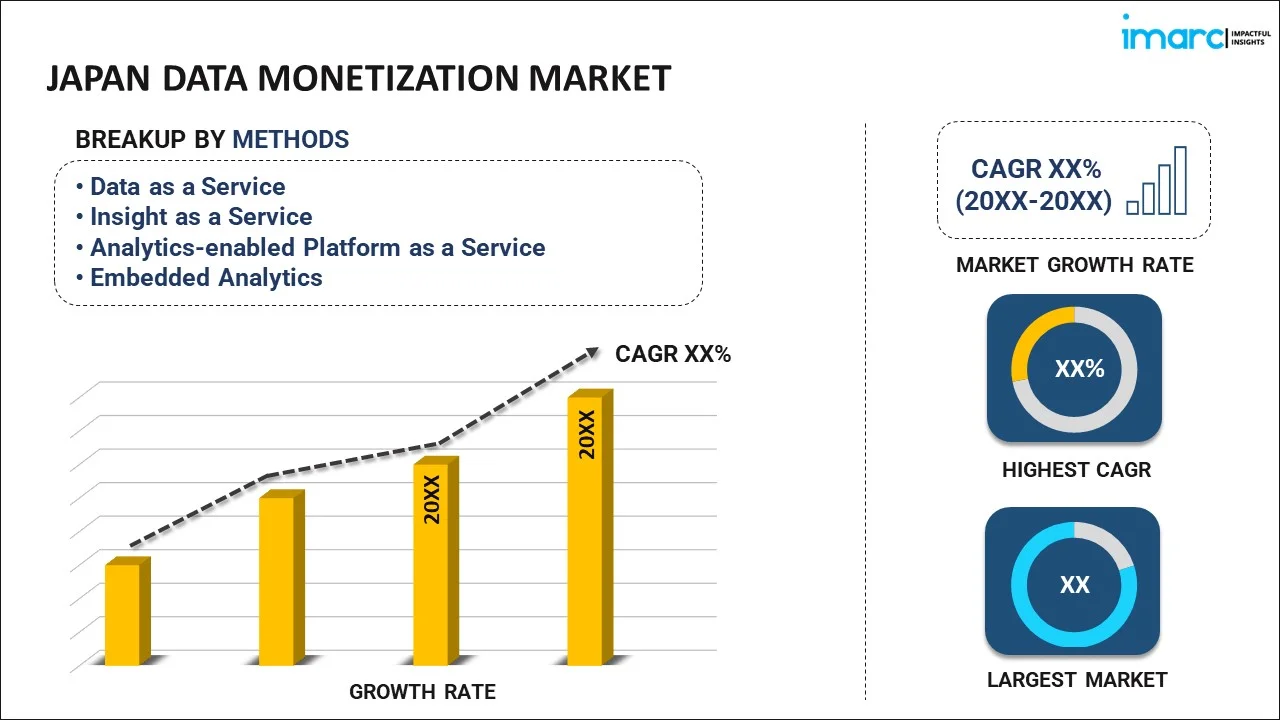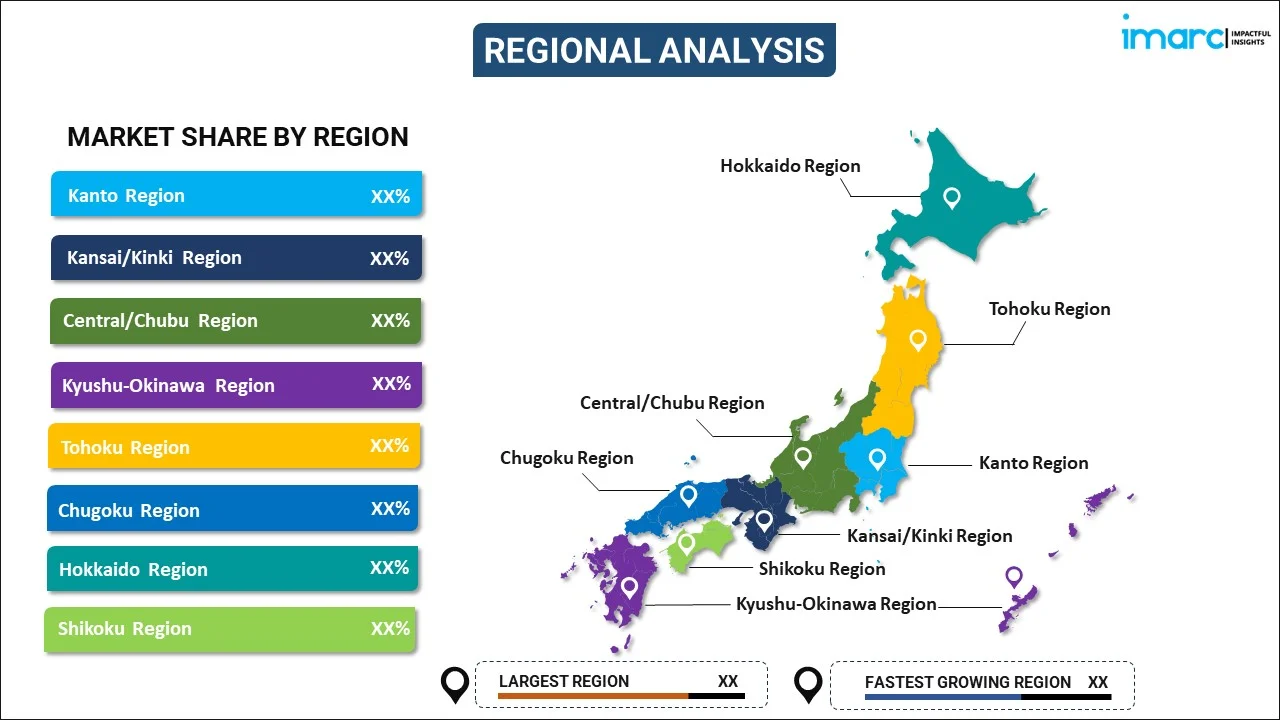
Japan Data Monetization Market Report by Method (Data as a Service, Insight as a Service, Analytics-enabled Platform as a Service, Embedded Analytics), Organization Size (Large Enterprises, Small and Medium-sized Enterprises), End Use (BFSI, E-commerce and Retail, IT and Telecommunications, Manufacturing, Healthcare, Energy and Utilities, and Others), and Region 2025-2033
Market Overview:
Japan data monetization market size reached USD 242.0 Million in 2024. Looking forward, IMARC Group expects the market to reach USD 429.0 Million by 2033, exhibiting a growth rate (CAGR) of 6.59% during 2025-2033. The increasing growth in data volume, mainly due to the rise of the Internet of Things (IoT) and smart devices that provides an immense repository for businesses to tap into, is primarily driving the market.
|
Report Attribute
|
Key Statistics
|
|---|---|
|
Base Year
|
2024 |
|
Forecast Years
|
2025-2033
|
|
Historical Years
|
2019-2024
|
| Market Size in 2024 | USD 242.0 Million |
| Market Forecast in 2033 | USD 429.0 Million |
| Market Growth Rate (2025-2033) | 6.59% |
Data monetization is the process of generating measurable economic benefits from available data sources. Typically, these benefits accrue as revenue or cost savings. In an era where data is hailed as the new oil, organizations across sectors are looking to leverage their vast reservoirs of user data, transactional data, or sensor data to drive business value. This process may involve selling data directly, improving existing products/services with data, or creating entirely new revenue streams. For instance, a company might sell its data to market research firms or use insights derived from analytics to optimize its operations and reduce costs. Additionally, data can be monetized indirectly through enhanced business strategies, better-targeted marketing, or the creation of data-driven products. It’s imperative, however, that in the pursuit of monetization, organizations uphold the strictest standards of data privacy and ethical use, ensuring that user rights and regulations are never compromised. As data continues to grow in importance, mastering the art and science of data monetization becomes a competitive imperative for businesses.
Japan Data Monetization Market Trends:
The data monetization market in Japan is driven by several key factors. To begin with, the explosive growth of data generation is a primary catalyst. With the proliferation of digital platforms and devices, there is an unprecedented abundance of data. This data deluge provides organizations with an opportunity to extract value from their information assets. Additionally, advancements in technology play a pivotal role. The advent of sophisticated analytics tools and machine learning algorithms enables companies to unlock valuable insights from their data, making it increasingly feasible to monetize information. Moreover, the evolving regulatory landscape is a significant driver. Data privacy regulations, like GDPR and CCPA, compel organizations to handle data responsibly, which, in turn, encourages them to explore monetization strategies that comply with these regulations. Furthermore, the ongoing advancements in analytics and artificial intelligence that have equipped companies with sophisticated tools to process and derive meaningful insights from this data are expected to drive the data monetization market in Japan during the forecast period.
Japan Data Monetization Market Segmentation:
IMARC Group provides an analysis of the key trends in each segment of the market, along with forecasts at the country level for 2025-2033. Our report has categorized the market based on method, organization size, and end use.
Method Insights:

- Data as a Service
- Insight as a Service
- Analytics-enabled Platform as a Service
- Embedded Analytics
The report has provided a detailed breakup and analysis of the market based on the method. This includes data as a service, insight as a service, analytics-enabled platform as a service, and embedded analytics.
Organization Size Insights:
- Large Enterprises
- Small and Medium-sized Enterprises
A detailed breakup and analysis of the market based on the organization size have also been provided in the report. This includes large enterprises and small and medium-sized enterprises.
End Use Insights:
- BFSI
- E-commerce and Retail
- IT and Telecommunications
- Manufacturing
- Healthcare
- Energy and Utilities
- Others
The report has provided a detailed breakup and analysis of the market based on the end use. This includes BFSI, E-commerce and retail, IT and telecommunications, manufacturing, healthcare, energy and utilities, and others.
Regional Insights:

- Kanto Region
- Kansai/Kinki Region
- Central/ Chubu Region
- Kyushu-Okinawa Region
- Tohoku Region
- Chugoku Region
- Hokkaido Region
- Shikoku Region
The report has also provided a comprehensive analysis of all the major regional markets, which include Kanto Region, Kansai/Kinki Region, Central/ Chubu Region, Kyushu-Okinawa Region, Tohoku Region, Chugoku Region, Hokkaido Region, and Shikoku Region.
Competitive Landscape:
The market research report has also provided a comprehensive analysis of the competitive landscape in the market. Competitive analysis such as market structure, key player positioning, top winning strategies, competitive dashboard, and company evaluation quadrant has been covered in the report. Also, detailed profiles of all major companies have been provided.
Japan Data Monetization Market Report Coverage:
| Report Features | Details |
|---|---|
| Base Year of the Analysis | 2024 |
| Historical Period | 2019-2024 |
| Forecast Period | 2025-2033 |
| Units | Million USD |
| Scope of the Report | Exploration of Historical and Forecast Trends, Industry Catalysts and Challenges, Segment-Wise Historical and Predictive Market Assessment:
|
| Methods Covered | Data as a Service, Insight as a Service, Analytics-enabled Platform as a Service, Embedded Analytics |
| Organization Sizes Covered | Large Enterprises, Small and Medium-sized Enterprises |
| End Uses Covered | BFSI, E-commerce and Retail, IT and Telecommunications, Manufacturing, Healthcare, Energy and Utilities, Others |
| Regions Covered | Kanto Region, Kansai/Kinki Region, Central/ Chubu Region, Kyushu-Okinawa Region, Tohoku Region, Chugoku Region, Hokkaido Region, Shikoku Region |
| Customization Scope | 10% Free Customization |
| Post-Sale Analyst Support | 10-12 Weeks |
| Delivery Format | PDF and Excel through Email (We can also provide the editable version of the report in PPT/Word format on special request) |
Key Questions Answered in This Report:
- How has the Japan data monetization market performed so far and how will it perform in the coming years?
- What has been the impact of COVID-19 on the Japan data monetization market?
- What is the breakup of the Japan data monetization market on the basis of method?
- What is the breakup of the Japan data monetization market on the basis of organization size?
- What is the breakup of the Japan data monetization market on the basis of end use?
- What are the various stages in the value chain of the Japan data monetization market?
- What are the key driving factors and challenges in the Japan data monetization?
- What is the structure of the Japan data monetization market and who are the key players?
- What is the degree of competition in the Japan data monetization market?
Key Benefits for Stakeholders:
- IMARC’s industry report offers a comprehensive quantitative analysis of various market segments, historical and current market trends, market forecasts, and dynamics of the Japan data monetization market from 2019-2033.
- The research report provides the latest information on the market drivers, challenges, and opportunities in the Japan data monetization market.
- Porter's five forces analysis assist stakeholders in assessing the impact of new entrants, competitive rivalry, supplier power, buyer power, and the threat of substitution. It helps stakeholders to analyze the level of competition within the Japan data monetization industry and its attractiveness.
- Competitive landscape allows stakeholders to understand their competitive environment and provides an insight into the current positions of key players in the market.
Need more help?
- Speak to our experienced analysts for insights on the current market scenarios.
- Include additional segments and countries to customize the report as per your requirement.
- Gain an unparalleled competitive advantage in your domain by understanding how to utilize the report and positively impacting your operations and revenue.
- For further assistance, please connect with our analysts.
 Inquire Before Buying
Inquire Before Buying
 Speak to an Analyst
Speak to an Analyst
 Request Brochure
Request Brochure
 Request Customization
Request Customization




.webp)




.webp)












